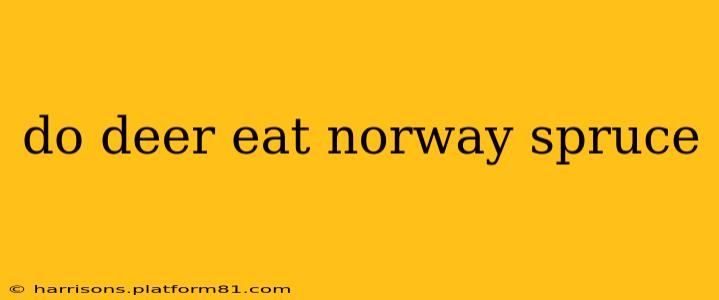Do Deer Eat Norway Spruce? A Deep Dive into Deer Browsing Habits
Deer, those graceful and sometimes destructive creatures, have a varied diet that changes with the seasons and availability of food. While they're known for their preference for certain plants, the question of whether they consume Norway spruce (Picea abies) is a common one. The short answer is: yes, but with caveats. Deer will eat Norway spruce, but it's not typically a preferred food source. Their consumption depends on several factors, making it a complex issue.
What Do Deer Typically Eat?
Before diving into the specifics of Norway spruce, let's understand the broader deer diet. Deer are herbivores, primarily browsing on various plants, including:
- Forbs: These are broad-leafed herbaceous plants, often the most appealing part of a deer's diet.
- Grasses: Especially important in spring and summer, grasses provide essential nutrients.
- Shrubs: Deer browse on the leaves and twigs of many shrubs, depending on species and availability.
- Fruits and nuts: Seasonal treats that supplement their diet, providing energy-rich carbohydrates.
- Twigs and buds: During winter months, when other food sources are scarce, deer often resort to consuming the twigs and buds of trees and shrubs. This is where Norway spruce comes into the picture.
Will Deer Eat Norway Spruce? A Detailed Look
Deer generally avoid eating conifers unless other food sources are extremely limited. Norway spruce, with its needles and tough branches, isn't particularly palatable or nutritious compared to more tender vegetation. However, in situations of severe winter food shortages, a deer might browse on the needles and even young twigs of a Norway spruce tree. This is often a last resort, and the amount consumed will be minimal compared to their preferred foods.
Why Don't Deer Prefer Norway Spruce?
Several factors contribute to the lower preference of Norway spruce among deer:
- Low Nutritional Value: Compared to forbs and other plants, spruce needles have a lower nutritional value, offering less energy and essential nutrients.
- Tough Texture: The needles are tough and prickly, making them difficult to chew and digest efficiently.
- Presence of Resins: Norway spruce needles contain resins that can be unappealing to deer, potentially causing digestive discomfort.
How Can I Protect My Norway Spruce from Deer?
If you're concerned about deer damaging your Norway spruce, several protective measures can be employed:
- Physical Barriers: Fencing is the most effective way to keep deer away from your trees.
- Repellents: Commercial deer repellents can be used, though their effectiveness can vary depending on the product and the deer population density. These often need to be reapplied regularly, especially after rain.
- Planting Location: Carefully consider the location of your Norway spruce. Planting them near areas where deer are less likely to browse can reduce the risk of damage.
What Other Trees Do Deer Eat?
While Norway spruce isn't a favorite, deer will browse on other trees and shrubs, depending on their availability and nutritional value. Some examples include:
- Maple: Deer readily consume the leaves and twigs of maple trees.
- Oak: Acorns are a prized food for deer, and they will also browse on oak leaves and twigs.
- Birch: Deer often feed on birch leaves and twigs, especially during winter months.
Are Deer a Threat to Mature Norway Spruce Trees?
Generally, deer are not a significant threat to mature Norway spruce trees. Their browsing is more likely to affect young saplings or seedlings, which are more vulnerable to damage. Mature trees are usually strong enough to withstand some browsing without significant harm.
In conclusion, while deer can eat Norway spruce, it's not a preferred food source. Their consumption primarily happens during periods of food scarcity. Understanding deer browsing habits and employing appropriate protective measures can safeguard your Norway spruce trees, ensuring they thrive.
